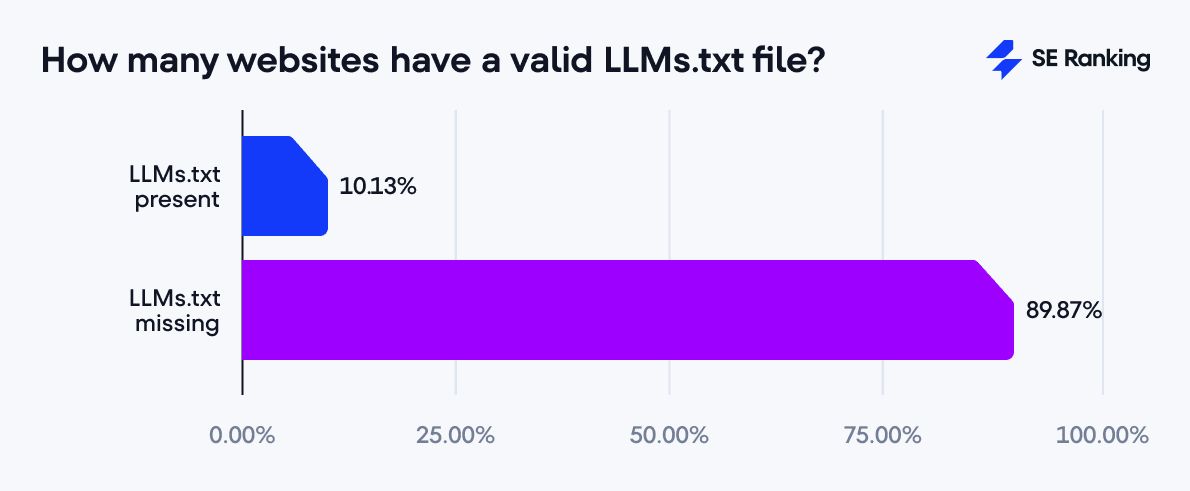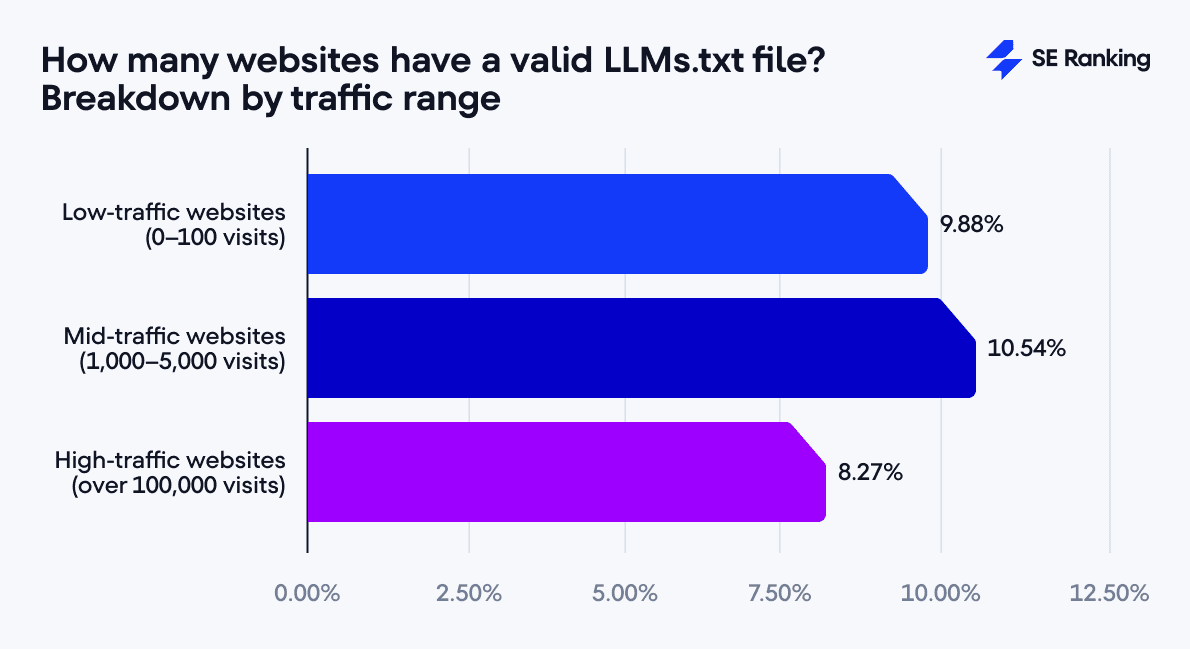Does LLMs.txt impact your AI visibility and citations? No, according to research
In 2025, website owners and marketers have been under growing pressure to make sure their content is visible to AI systems. LLMs.txt promises an easy fix: a single file that points models to your most important pages.
It sounds promising. But does it actually make a difference?
We analyzed 300,000 domains to find out. Here’s what our data shows.
-
LLMs.txt is a newly proposed “AI robots.txt.”
It’s a simple file designed to highlight a website’s most important content for LLMs. The goal is to help AI systems more easily find, interpret, and cite a site’s key pages.
-
Only about 1 in 10 websites use LLMs.txt.
In our dataset of nearly 300,000 domains, just 10.13% had an LLMs.txt file in place. That’s a long way from the universal adoption of standards like robots.txt or sitemaps.
-
There’s no correlation between AI citations and LLMs.txt.
Both statistical analysis and machine learning showed no effect of LLMs.txt on how often a domain is cited by LLMs. Removing this variable from our XGBoost model actually improved its accuracy. This means that LLMs.txt might currently introduce more noise than value.
What is the LLMs.txt file?
So, first things first: what exactly is LLMs.txt?
It’s a proposed standard file (typically located at your site root, e.g., https://example.com/llms.txt) intended to act as an “AI sitemap.”
In theory, this file can:
- Specify which AI crawlers or models can access your website and which areas are restricted.
- List pages, datasets, or APIs that are approved for AI use.
- Provide metadata or usage terms (e.g., licensing info, attribution rules, or rate limits) for AI models referencing your content.
In short: it provides AI crawlers with a roadmap to your site’s most valuable information.
The hype around LLMs.txt took off in mid-2024 when several high-profile developers, SEO experts, and AI researchers began discussing it as a possible “missing link” between websites and generative AI systems.
Because it builds on familiar web standards like robots.txt and XML sitemap, many hoped it might evolve into a new convention for AI indexing and citation.
However, as of now, there’s no clear evidence that major AI platforms are actively using LLMs.txt in their data pipelines:
- Google has stated that its AI Overviews and AI Mode continue to rely on traditional SEO signals instead of LLMs.txt.
- OpenAI recommends allowing its web crawlers, such as OAI-SearchBot, in your site’s robots.txt file. However, there’s no confirmation that LLMs.txt affects how ChatGPT ranks or cites content.
- Some SEO logs show GPTBot sometimes fetches LLMs.txt files, though this doesn’t happen often.
At this stage, LLMs.txt is not yet an established or widely adopted standard within the AI industry. But things change fast in this field, and what’s true today might be outdated in just a few weeks.
That’s why we decided to test this file ourselves to see if it actually works.
Here’s what our findings reveal.
How many domains use the LLMs.txt?
Let’s start by looking at how many websites actually use it.
Out of the nearly 300,000 domains we analyzed, only 10.13% had an LLMs.txt file in place. That means almost 9 out of 10 sites haven’t adopted it yet.

This makes LLMs.txt a niche practice with very limited adoption. By comparison, standards like robots.txt or sitemaps are almost universal. LLMs.txt, meanwhile, is still far from that level of recognition.
Put simply, there’s plenty of curiosity, but very little real-world use so far.
Do high-performing domains use LLMs.txt more often?
It might seem logical to assume that big, authoritative websites would be the first to jump on LLMs.txt. After all, large domains often have the resources and motivation to experiment early. But when we looked at the data, the pattern wasn’t what many would expect.

- Websites with low traffic (0–100 visits): 9.88% adoption
- Websites with mid traffic (1,001–5,000 visits): 10.54% adoption
- Websites with high traffic (100,001+ visits): 8.27% adoption
The percentages are remarkably close. Sites with only a few dozen visits a month adopt LLMs.txt at nearly the same rate as those with thousands of visitors. And surprisingly, the biggest, most established sites are actually slightly less likely to use the file than mid-tier ones.
The use of LLMs.txt isn’t concentrated among industry leaders or “insiders.” Instead, it’s spread almost evenly across the web. In other words, LLMs.txt isn’t yet a best practice for top domains or a secret advantage used by high performers. Right now, it looks more like a scattered experiment, with small and mid-sized sites just as likely to try it as larger ones.
Does LLMs.txt correlate with AI citation frequency?
To answer this, we tested how the presence of LLMs.txt impacts how often a domain is cited by LLMs.
For this, we built a machine learning model using XGBoost, an algorithm that finds patterns and makes predictions. The model looked at how often different domains are cited, considering several factors (including whether they have an LLMs.txt file).
Surprisingly, when we removed the LLMs.txt factor, the model’s predictions actually improved. It became more accurate and reliable on test data. This means that the presence of LLMs.txt wasn’t helping the model understand citation behavior. It was actually adding noise or confusing information.
To sum it up, having an LLMs.txt file didn’t make a domain more likely to be cited by AI models. In fact, the model performed better without it. So, LLMs.txt doesn’t seem to directly impact AI citation frequency. At least not yet.
Should you implement LLMs.txt on your site?
It really depends on what you want to achieve.
If you’re curious about new web standards or value openness in how online content is used, there’s little downside. The file is small, simple to create, and poses no technical risk.
Still, if you’re hoping for clear, measurable benefits (like more AI citations and, as a result, traffic), you’ll likely be disappointed. There’s no sign yet that LLMs are relying on this file in a way that affects websites.
LLMs.txt won’t change much for you today. But including it now could make your site easier to work with if (or when) the format becomes widely adopted later on.
Brief methodology overview
To test whether LLMs.txt impacts AI visibility or citations, we designed a structured, multi-step analysis. The goal was to evaluate adoption rates, traffic correlations, and measurable impact on LLM citation frequency.
For this, we analyzed 300,000 domains, capturing:
- Presence or absence of an LLMs.txt file
- Traffic levels (low, mid, high)
- Citation frequency in AI model outputs
Our focus was domain-level citations (how often each site appeared as a source across sampled LLM responses).
We combined traditional statistical methods with machine learning models to assess both correlation and predictive value:
- Spearman correlation
- XGBoost regression
- SHAP analysis
Disclaimer: The results we share reflect the relative importance of factors within the specific model and dataset tested. Since these factors interact with each other, results can change if some are added or removed. As such, these findings should be seen as context-dependent.
Conclusion
Our analysis of 300,000 domains shows that LLMs.txt doesn’t impact how AI systems see or cite your content today. Even so, adding the file is a low-effort way to prepare for the next wave of AI indexing. Today it’s optional; tomorrow, it might be essential.

